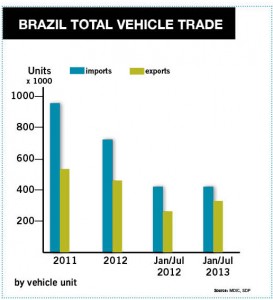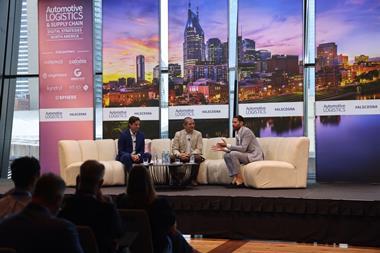
Brazil, which for a decade has been on the mighty march of the BRIC economies, has recently seen its growth sputter. GDP is estimated to grow at around 1-2% this year, with inflation hovering at about 6% and its currency, the real, tumbling against the US dollar. The automotive industry has seen slowdowns too, including in the once blustering vehicle trade at the country’s ports and borders. Vehicle imports and exports fell to 1.19m in 2012 versus 1.51m in 2011, with many of the main gateways for new vehicles seeing sharp declines.
Volumes continue to wobble this year, except for some recovery in vehicle exports, with uncertainty looming. Lourenço Fregonese, director of port administration at the ports of Paranaguá and Antonina (APPA) warns that this year could be even worse for imports and exports than last year. "Fewer people are purchasing cars as the domestic economy slows, while overseas markets continue to face difficulties," he says.
Meanwhile, with infrastructure in Brazil and Argentina lagging even the weak growth, bottlenecks in ports for finished vehicles and containers remain an issue – although there are signs that investment in ports is starting to increase.
Peter Gyde, managing director of Maersk Line Brazil, says that although Brazilian ports have developed widely and have received private investment to reach international standards, the dwell time for containers is still 21 days, while internationally this would take 2-4 days. Truckers may also need to wait 12-24 hours outside of ports, and this leads to extra costs and knock-on effects for all cargo moving through the ports, including finished vehicles.
"The heavy bureaucracy and paperwork clog up the system," he says.
The transport of finished vehicles has been made even more difficult by a series of strikes that swept across the country in June. Henrique Machado, logistics manager at agricultural manufacturer Agco South America, recalls that the delivery of tractors and combine harvesters was impacted by widespread street protests that blocked highways, although OEMs were generally able to bring forward parts and outbound deliveries.
Market watchers do see positive signs in port development, however, in particular new Brazilian legislation to regulate port privatisations, which should attract more public-private partnerships and investment. Supply chain players are hopeful that this will lead to modernisation of the infrastructure and a reduction in transport costs.
Fregonese at APPA says that the government is now prioritising investment after years of neglect, including plans to pump funds into port and infrastructure projects and to offer concessions of 25 years to existing port concession holders. Paranaguá and Antonina, some 400km south of São Paulo, are already investing in more space for finished vehicles. Expansions include R$10m ($4.2m) for a project to build a 120,000 square metre patio with storage capacity for some 4,000 cars, which would increase annual capacity at the port to 150,000 vehicles. The ports also plan to build a 60,000 square metre vertical patio.
One outcome of crowded ports and access roads in both Brazil and Argentina is the use of off-port facilities. Agco’s Machado says that the main problem is the 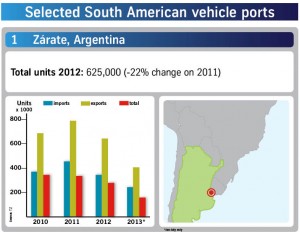 lack of parking space and pre-trip inspection facilities in ports. In the case of the port of Santos, near São Paulo, Agco cannot drive the tractors straight to the port; vehicles need to wait one week at a dry terminal before being able to enter the port.
lack of parking space and pre-trip inspection facilities in ports. In the case of the port of Santos, near São Paulo, Agco cannot drive the tractors straight to the port; vehicles need to wait one week at a dry terminal before being able to enter the port.
Maersk's Gyde agrees that local trucking companies are also using more off-dock facilities for container and vehicle handling, but these facilities do not solve the problems. "The truckers still need to wait...it's just a plaster on the wound," he warns.
In Argentina, Alejandro Van Thillo, vehicle division general manager at Terminal Zárate (TZ), South America’s largest port for finished vehicles, says various off-port yards have also sprung up near to TZ in a 15km radius during the last two years. The main local trucking companies in Argentina have developed these yards for crossdocking operations when distributing vehicles to dealers, he says.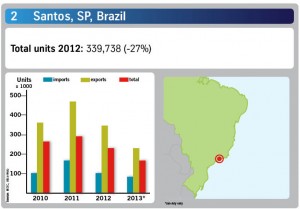
Looking to containers
Given the build-up of volumes inside the ports and the congestion at satellite facilities, Mario Veraldo, Maersk's head of sales, says manufacturers – especially up-market players such as BMW and Land Rover – are increasingly using containers to move cars. Using this method, carmakers benefit from being able to store containers in different parts of ports rather than just relying on crowded patios. This activity is still relatively small in terms of volumes, but it should grow, he adds.
Moreover, as carmakers expand in Brazil, they bring in machinery and equipment to the country along with vehicles, Veraldo says. Maersk has helped set up factories for newcomers to the market, such as South Korea's Hyundai and Chinese manufacturers. The shipping company also moves containers from existing  manufactures, such as GM or Ford, that import parts and complete-knockdown kits (CKD).
manufactures, such as GM or Ford, that import parts and complete-knockdown kits (CKD).
Maersk is testing remote tracking for containers in Brazil. The lines are well developed and have weekly flows to Europe and Asia. The company handles on average 15,000 CKD containers to the region annually, he says.
Argentina's TZ eyes space
Zárate, which is part of Buenos Aires, works with all of the carmakers established in Argentina, including Volkswagen, Ford, General Motors, Fiat and Peugeot. Van Thillo says that TZ's main commercial focus in 2013 is to attract new clients for added-value services such as PDI services, accessorising vehicles, maintenance and yard-to-yard transport. "With this course of action, we intend to broaden our services and develop custom-made solutions to our clients, " he says. 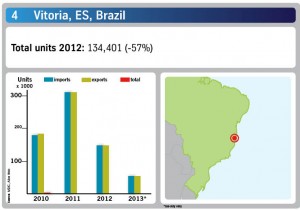
Argentina's auto industry has maintained strong production, sales and exports. However, Van Thillo says that they could slow later this year, particularly if Brazil’s sales head further south.

Argentina sees around 80% of its finished vehicle exports concentrated in Brazil. Maritime transport competes with transport by land, and shifts from vessel to road directly impact the operational volumes at the port.
To help handle vehicle flows, last year the port finished new PDI and car washing facilities of 3,500 square metres, adding to 4,200 square metres of existing warehousing. The new facilities were especially designed to offer value-added services. In 2012, the port pumped $10m into the development and a further investment was approved of $8.5m.
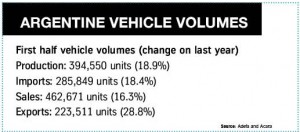 This year TZ has invested in more new parking yards in the port area that should be operational by the end of the year, including a further eight hectares suitable for a capacity of 4,000 cars. Another 16 hectares, located next to the vehicle distribution area, are already being developed for the
This year TZ has invested in more new parking yards in the port area that should be operational by the end of the year, including a further eight hectares suitable for a capacity of 4,000 cars. Another 16 hectares, located next to the vehicle distribution area, are already being developed for the 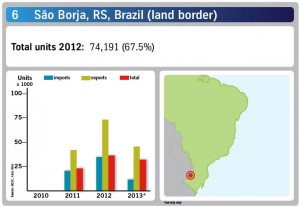 expansion of parking slots in the next two years, depending on demand. The use of custom-bonded yards for long periods will still be a trend because of a special import affidavit policy in Argentina needed to obtain customs clearance for vehicles, says Van Thillo.
expansion of parking slots in the next two years, depending on demand. The use of custom-bonded yards for long periods will still be a trend because of a special import affidavit policy in Argentina needed to obtain customs clearance for vehicles, says Van Thillo.
TZ has also been improving its vehicle tracking and tracing system. The terminal is focused on a series of online connectivity projects with OEM systems, while registry and tracking of vehicles through RFID is also being integrated.
The tracking and tracing of vehicles is performed by an IT system that the port developed and customised for the terminal and its customers’ needs. The port is adding new features, including an extranet page for enquiries into a vehicle's status, while working with manufacturers individually to develop interface tools.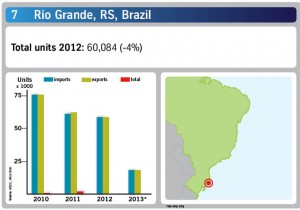
Bigger and bigger agricultural equipment
Even though the Brazilian economy has been growing at a sluggish rate, farmers are expected to produce a bumper crop this year, while areas such as the northeast are also being cultivated. Agricultural manufacturers are seeing volume increases, and it is important to prepare the carriers for the heavier volumes, says Agco's Machado.
Agco also needs to adjust to the market's demand for bigger tractors. New areas need bigger machines such as combine harvesters and larger, more powerful tractors. "This means that Agco needs more and bigger trailers for longer trips," Machado says.
Agco transports around 36,000 tractors a year to some 150 dealers spanning the entire country. The company has various Brazilian factories such as in Mogi das Cruzes in São Paulo state, 60km from Santos port, or Canoas in Rio Grande do Sul, 300km from Rio Grande port.
While Brazil's roads in the south and southeast of the country allow for smoother transport of high-and-heavy vehicles, the connections between some cities can be poor. For instance, while the main route between the states of Rio Grande do Sul and São Paulo offer reasonable access, the last mile is usually the most difficult. Machado notes that most large-scale farms have at least one decent access road and, if not, the farmers can usually transport the tractor or even drive it to the final destination.

Agco uses transport companies Atrhol, Lisolt and Falcão to haul its finished vehicles. Tractors are moved by Atrhol and Falcão from the municipalities of Canoas and Mogi das Cruzes to Argentina, for example.
Agco exports tractors and machinery through two terminals in São Paulo: Deicmar in Santos and Santos Brasil in Guarujá. The small tractors can be shipped in containers, while the bigger tractors and harvesters need ro-ro vessels.
In the last few years, Agco has been focusing mainly on two initiatives to improve accuracy for predicting arrival times. Firstly, it now has trucks that are fully 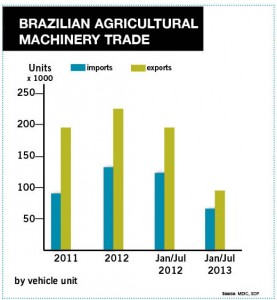 equipped with GPS to deliver both tractors and combine harvesters. "We can control the exact delivery dates to measure on time deliveries and act on deviations," Machado says.
equipped with GPS to deliver both tractors and combine harvesters. "We can control the exact delivery dates to measure on time deliveries and act on deviations," Machado says.
Agco has also established targets and measures to reduce variation. It runs weekly reviews and meets with its carriers to address any regions where targets aren’t being met. Finally, Agco has reduced its delivery-target time to serve customers faster, he adds.
Agco delivers machinery across Latin America. It moves tractors to Uruguay and Chile from Brazil by road, while using vessels for Venezuela, Peru and Ecuador. For ocean-bound exports, Agco sprays the products to protect them from the salt, and removes the wheels or uses slave wheels for specific regions, Machado says.
He explains that GPS-equipped trucks take two or three days to deliver their loads, while importing can take ten or more days. He has hope that two new private container terminals that are being built in Santos will help relieve capacity.
Working closely with customers
Logistics provider Gefco uses both road and maritime transport to shift vehicles between Brazil and Argentina. The transit time for this route is seven working days. André Bortolotto, the compnay's director of automotive logistics operations in Brazil, says that Gefco controls the transport process from the original departure point through to the final destination, working closely with transport suppliers and holding monthly performance meetings. [sam_ad id=6 codes='true']
Challenges for Gefco include the conditions for berthing and unloading of cargo in the ports of Rio de Janeiro and nearby Sepetiba, as well as delays at Santos port during the harvest. “We manage the situation by reviewing, in conjunction with the client, every step of delivering vehicles, and working together with port operations,” he says.
In the ports, Gefco offers services to prepare cars for shipment, including the installation of accessories or optional items, such as alarms, or carrying out PDI, such as cleaning, mechanical and electrical tests. Gefco also ensures that the final quality is controlled before shipment to the dealerships. Currently, Gefco handles 100% of Citroën vehicles and 30% of Peugeots in the market.
The big get bigger
Although the Brazilian market has been slow, some providers have been able to gain further market share. According to Gennaro Oddone, president of Brazilian vehicle logistics provider Tegma, the company’s transport volume is up 14% in the first half of this year compared to last year at 523,300 vehicles.
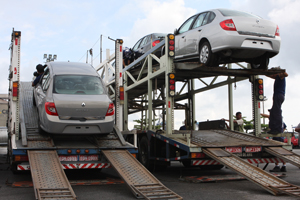
As well as storing the units and helping with the unloading of imports, the company provides PDI services that prepare the vehicles to be sent to dealers, as well as to meet the standards of national legislation. Oddone explains that evaluation criteria are included in agreements with each customer, and this is always being evaluated.
Oddone expects that improvements in Brazil's ports should help logistics providers such as Tegma in the coming years. These changes should reduce waiting times for vehicles to be loaded and unloaded – which would be a most welcome and necessary relief for Brazil's congested outbound supply chain.
































